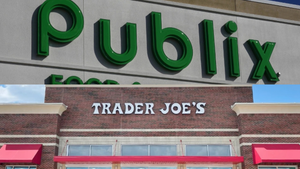Target Q2 earnings drop in wake of ‘rightsizing’ actionsTarget Q2 earnings drop in wake of ‘rightsizing’ actions
Comparable sales rise 2.6%, with digital sales up 9%
August 17, 2022

Target Corp. saw sales edge up but earnings plunge in its fiscal 2022 second quarter following a recent action plan to “rightsize” its inventory and pare costs.
Minneapolis-based Target said Wednesday that net sales for the quarter ended July 30 totaled $25.65 billion, up 3.3% from $24.83 billion a year earlier, when the company posted a 9.4% increase. Overall revenue rose 3.5% to $26.04 billion, compared with a 9.5% gain to $25.16 billion a year ago.
Comparable sales in the 2022 second quarter edged up 2.6% year over year, with transactions up 2.7% but average transaction size flat. That compared with a 8.9% comp-sales gain in the 2021 quarter, when transaction count surged 12.7% but the average ticket shrank 3.4%.

Grocery remained a bright spot for Target in the second quarter as consumer spending in nondiscretionary categories remained strong.
Target said the Q2 comp-sales uptick — its 21st consecutive quarter of growth — reflected ongoing strength in food and beverages, beauty and household staples. The retailer reported that it added unit share in all five of its core merchandising categories, which also include apparel and accessories, hardlines, and home furnishings and decor.
“I’m really pleased with the underlying performance of our business, which continues to grow traffic and sales while delivering broad-based unit-share gains in a very challenging environment, Target Chairman and CEO Brian Cornell said in a statement.
On a comparable basis, digital sales rose 9% in the 2022 second quarter atop a 9.9% increase in the prior-year period. Sales in same-day services — Order Pickup (in-store pickup), Drive Up (curbside service) and Shipt (same-day delivery) — climbed almost 11% in the quarter, led by Drive Up, which grew in the mid-teens percentage after rising more than 80% a year ago. More than 95% of Target’s Q2 sales were filled by its stores.
At the bottom line, Target posted 2022 second-quarter net income of $183 million, or 39 cents per diluted share, compared with $1.82 billion, or $3.65 per diluted share, a year earlier. Adjusted net earnings per share (EPS) also were 39 cents (diluted) versus $3.64 in the prior-year period.
Target noted that its inventory actions in the second quarter reduced its inventory exposure in discretionary categories and shifted investment to faster-growing frequency categories. In addition, fall season receipts in discretionary categories were cut by more than $1.5 billion, the company said.

Comparable sales for same-day services climbed 11% in the quarter, with Drive Up curbside pickup rising by a mid-teens percentage.
Analysts, on average, had forecast Target’s second-quarter adjusted EPS at 73 cents, with estimates ranging from 61 cents to 98 cents, according to Refinitiv.
“I want to thank our team for their tireless work to deliver on the inventory rightsizing goals we announced in June. While these inventory actions put significant pressure on our near-term profitability, we’re confident this was the right long-term decision in support of our guests, our team and our business,” Cornell commented. “Looking ahead, the team is energized and ready to serve our guests in the back half of the year, with a safe, clean, uncluttered shopping experience, compelling value across every category, and a fresh assortment to serve our guests’ wants and needs.”
In June, Target announced that, after higher costs and overstocks resulted in a disappointing first quarter, the company was enacting a plan to hone its inventory for fiscal 2022 and add more flexibility to adapt its sales mix to changes in customer demand and business conditions.
Efforts included more markdowns, sifting out excess inventory and order cancellations. Farther up the supply chain, the company added holding capacity near U.S. ports to bring more leeway and speed to parts of the supply network most affected by external volatility, as well as worked with suppliers to shorten distances and lead times. Target, too, fine-tuned pricing in response to “unusually high transportation and fuel costs” and updated sales forecasts, promotional plans and cost projections by category.
With shoppers adjusting their behavior in response to elevated inflation, the retailer said it expects ongoing strength in frequency-related categories such as food and beverages, household essentials and beauty but was “planning more conservatively” in discretionary categories such as home, which has seen significant flux in demand since the start of the year.
Target finished the second quarter with 1,937 stores overall, compared with 1,909 a year ago. Of its brick-and-mortar base, 1,521 stores are 50,000 to 169,999 square feet, 273 locations are 170,000 square feet or more, and 143 stores are 49,999 square feet or less. Five new stores were opened in the 2022 quarter, when the retailer also notched its 1,000th store remodel completed since 2017.
“Q2 results were mixed, with sales, comps and margins below expectations. The inventory purge was the key impact, burdening gross margin percentage, which was down 900 basis points year over year. Offsetting, the company tightened expenses,” Jefferies analyst Stephanie Wissink wrote in a research note on Wednesday.
“Comps of 2.6% were below estimates at 2.8%, driven entirely by transactions ( 2.7%) with average transaction value flat year over year,” she said. “Consumers continue to shift toward necessities. Food and beverage, beauty and household ssentials were drivers. Target cited unit gains in all five core merchandising categories. Stores’ 1.3% [comp-sales gain] was lower than expected; digital 9% was in line. Validating [Target’s] stores-as-hubs approach, 95% of digital sales were fulfilled by stores, and same-day services grew 11%, led by Drive Up mid-teens%.”
About the Author
You May Also Like






